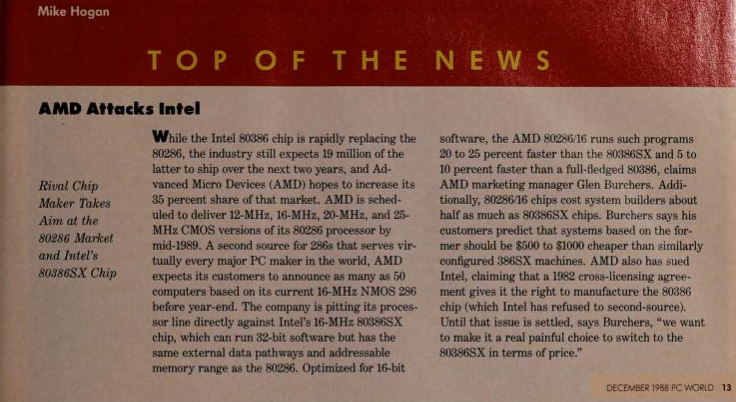Can I Get a 286 To Run Like a 386?
14th October 2021
OK, right out of the gate I want to say a few things about the venerable Intel 80286 microprocessor.
At its launch in 1982, the 80286 was most certainly a leap ahead of the 8086 (and 8088). It remedied several shortcomings of its forebears, such as the 640 kilobyte memory limit and introduced a new "protected mode" where each program could run in its own distinct memory space, thus eliminating the potential for corruption when multitasking. Both Windows/286 and OS/2 operating systems made use of the 286's new mode, but for most of us who remained with DOS which ran in "real mode", the key benefits of the 286 were never realised.
The challenge here was the need for PC microprocessors to always remain 100% backward-compatible with their forebears so existing software would continue to run without problems. This, coupled with some inherent design limitations in DOS and the lack of adoption of fancy new windowed environments in the early 80s sadly mooted much of what Intel had put into the 286 architecture.
Introduced with a 6 MHz clock speed in the IBM 5170, it scored a MIPS (Millions of Instructions Per Second) rating of 1.2. Soon after, 8 and 10 MHz versions were also available, but the fastest version at launch was the 12.5 MHz one, coming in at a blistering 2.66 MIPS. When compared with the 8086, it was about three times as fast clock for clock.
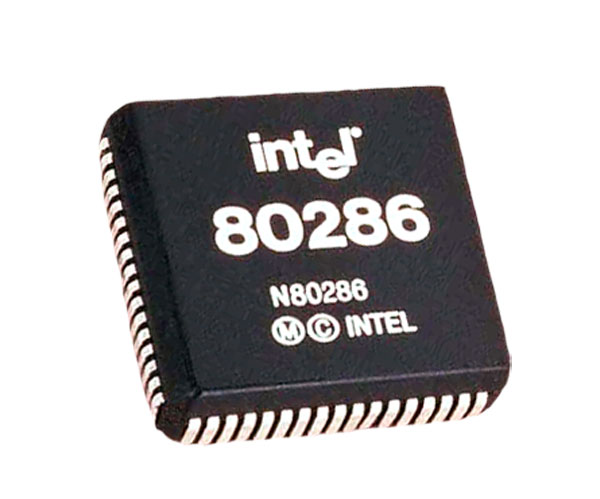
It's still a little surprising to think that my friends and I were running this sort of technology a decade after their initial release! I put this down to two things:
1) Brand new microprocessor technology was always very expensive when it first came out. The 80286 microprocessor alone was about $2,000 US dollars (£1,100) at launch. Skip forward 4 years and a typical PC builder would be able to source a slow 80286-8 at about £120 for the CPU. This would mean a full system build around that CPU would start at around £1,600 retail in 1986.
2) The PC market was very good at catering to every price point. Skip forward a full 5 years to 1991 and the most budget-oriented PC was still running a green-screen 8088 CPU for the price of around £300! A 286 would be £500 and a slow 386 would be £600. Remember I mentioned about backward compatibility? Here it was in all its glory - nearly all application software would run just as well on an older PC as a brand new one (only much slower), which made the PC something very useful to own at whatever budget you had.
The Harris/Intersil 25 MHz
Harris Semiconductor, along with AMD, Fujitsu, Siemens and several other companies with chip fabrication facilities in the U.S. had a longstanding contract with Intel to manufacture Intel's microprocessors. When Intel shifted their focus to their new 80386, they deliberately cut ties with their second source partners, which meant only Intel-branded (and Intel-fabricated) 386 chips would be available to the PC market.
Later on, AMD and Cyrix legally reverse-engineered the Intel 80386 to create their own close replicas that did not rely on getting Intel's permission, but I digress... back to the 286:
 Without a new 386 to manufacture, Intel's partners were stuck with the 16-bit 80286 platform. So what did they do? They created 286s that ran at ever higher clock speeds!
Without a new 386 to manufacture, Intel's partners were stuck with the 16-bit 80286 platform. So what did they do? They created 286s that ran at ever higher clock speeds!
The fastest 80286 CPU produced was the 25 MHz variant manufactured by Harris, who were later acquired by Intersil. This arrived in 1989, seven years after the first Intel 80286 hit the market and four years after they had launched the 386. Today, not only are these Harris CPUs quite rare, but finding a suitable motherboard on which to run one at that speed is an even bigger challenge.
286 motherboards tended to max out at 20 MHz with the main limiting factors being the chipset's ability to run at higher frequencies, and the motherboard design. Over its 10-years-or-so lifetime, the 286 was coupled with numerous chipsets created by Chips & Technologies, Texas Instruments, VLSI, Headland and others. While all of these allowed for a usable 286 PC, they varied in reliability and performance, though it would be difficult to detect any real differences between them on an average 286 running up to 16 MHz.
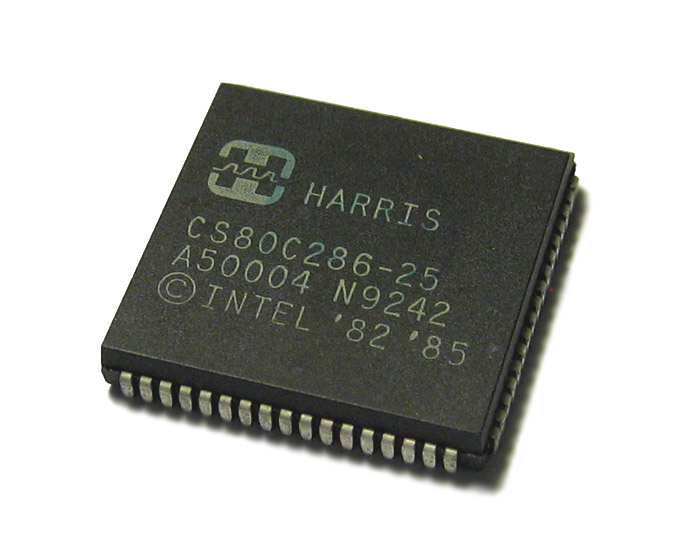 Oh, and you might have heard of the "Chang Modification" from late 1988 when a Taiwan-based company called Tienwei Computers declared they had produced a 40 MHz 80286 motherboard. The media saw it running benchmarks, and it all looked pretty legitimate - the world was astounded. Soon after they discovered it was all smoke and mirrors - he "gamed" the computer clock in such a way that the Landmark Speed Test gauge calculated performance incorrectly, making a system look about four times more powerful than it really was. This was achieved by making the DOS timer run slower, so effectively what is measured as "10 seconds" by a benchmark program would in reality take 20 seconds if you halve the DOS timer frequency.
Oh, and you might have heard of the "Chang Modification" from late 1988 when a Taiwan-based company called Tienwei Computers declared they had produced a 40 MHz 80286 motherboard. The media saw it running benchmarks, and it all looked pretty legitimate - the world was astounded. Soon after they discovered it was all smoke and mirrors - he "gamed" the computer clock in such a way that the Landmark Speed Test gauge calculated performance incorrectly, making a system look about four times more powerful than it really was. This was achieved by making the DOS timer run slower, so effectively what is measured as "10 seconds" by a benchmark program would in reality take 20 seconds if you halve the DOS timer frequency.
The Faster 80286 Chipsets
Fortunately for us today, we can look back and see that several reliable chipsets were produced that support running an 80286 processor at 20 to 25 MHz while decoupling the AT (ISA) bus so that it could run at the requisite 8 or 10 MHz. These include:
- Headland HT12/A (HT12 Rev.A) - 20 MHz limit and 4 MB RAM limit
- VLSI VL82C311L - designed for up to 25 MHz. Full 16 MB RAM support
- VLSI VL82C201 - designed for up to 20 MHz, but can reach 27.5 MHz
- Suntac ST62C251 - designed for up to 20 MHz
- UMC UM82C210 - designed for up to 20 MHz. Up to 8 MB RAM supported
- SA1 - supposedly good for 20 MHz, 16 MB RAM support
If you know of other fast 286-compatible chipsets, please let me know!
DISCLAIMER: I accept no responsibility for any accident, loss or damage incurred if you manipulate your motherboard and/or components to operate outside of the manufacturer's original specifications.
Before I get into the various 286 chipsets, as a set of baseline synthetic performance benchmarks I want to post a few results from 386 systems - do bear in mind this is not super-scientific; the findings of this article may not be reproducible elsewhere, and do not necessarily reflect real-world performance:
| Norton SI 6.0 Intel 80386DX-20, old C&T CS8230 386 chipset, 1 WS = 9.7 Intel 80386DX-20, old C&T CS8230 386 chipset, 0 WS = 12.3 AMD Am386DX-25, OPTi 495XLC chipset, 256K L2 = 18.2 AMD Am386DX-33, OPTi 495XLC chipset, no L2 = 16.9 AMD Am386DX-33, OPTi 495XLC chipset, 256K L2 = 26.0 AMD Am386DX-40, OPTi 495XLC chipset, 256K L2 = 31.2 Landmark 2.0 Intel 80386DX-20, old C&T CS8230 386 chipset, no L2 = 21.00 AMD Am386DX-33, OPTi 495XLC chipset, no L2 = 22.09 Intel 80386DX-25, OPTi 495XLC chipset, 256K L2 = 39.05 AMD Am386DX-33, OPTi 495XLC chipset, 256K L2 = 44.68 |
Landmark 6.0 AMD Am386DX-33, OPTi 495XLC chipset, no L2 = 32.02 AMD Am386DX-33, OPTi 495XLC chipset, 256K L2 = 47.7 Am386DX-40, OPTi 495XLC chipset, 256K L2 = 52.1 Dhrystones Intel 80386DX-33, OPTi 495XLC chipset, no L2 = 4,300 Intel 80386DX-33, OPTi 495XLC chipset, 256K L2 = 8,500 AMD Am386DX-40, OPTi 495XLC chipset = 11,947 |
Headland HT12/A
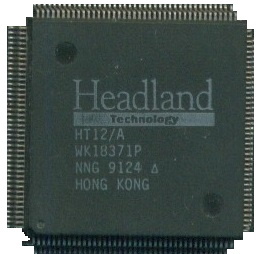 This chipset is possibly the most ubiquitous of the fast chipsets I am visiting today. I have seen numerous motherboard designs over the years that use the Headland HT12/A, and a plethora of Taiwan-based motherboard manufacturers in the early 90s made use of the faster speeds this could support towards the end of the 286s useful life.
This chipset is possibly the most ubiquitous of the fast chipsets I am visiting today. I have seen numerous motherboard designs over the years that use the Headland HT12/A, and a plethora of Taiwan-based motherboard manufacturers in the early 90s made use of the faster speeds this could support towards the end of the 286s useful life.
With the use of the HT12MM.SYS driver, you can get XMS and EMS memory in DOS. Alternatively, to get 64 KB of UMBs in which to load drivers, use “The Last Byte” memory manager by adding this to your CONFIG.SYS:
DEVICE=C:\TLBMM\LASTBYTE.SYS Physical=HT12,NOEMS,OVERRIDE
You can then use the hightsr utility to load your drivers high. I have a more complete article here on setting up XMS and EMS for this chipset.
As I understand it, the HT12 (not HT12/A) chipset officially supports CPUs up to 16 MHz, and the HT12/A takes it one step further to 20 MHz. Some folks have had success by replacing their motherboard's 40 MHz crystal oscillator with a 50 MHz one, which pushes the chipset to run at 25 MHz*.
*Incidentally, nearly all 286 motherboards operate in a CLK/2 fashion, so the crystal oscillator directly drives the microprocessor at half its frequency. In other words, 16 MHz motherboards will have a 32 MHz crystal for the CPU and 20 MHz motherboards will have a 40 MHz crystal.
Bear in mind that upgrading the oscillator may cause lock-ups, and will often result in higher temperatures being felt on the top of the CPU, chipset, RAM, and other supporting chips. It you are looking to overclock your 286 motherboard, you may want to reduce it from a 50 MHz crystal to something slightly slower like a 48 MHz or 44 MHz one if you are seeing problems. Also, when running anything over 20 MHz, you will likely need to add 1 or more wait states to get it to POST at all, or to run stable. Also use the fastest 60ns RAM from a good quality manufacturer if you can find some as this is more likely to cope with zero wait states.
Boards that are known to use the HT12 and HT12/A chipsets are:
- G2-12HS-16 / Quadtel HT12
- Eurosoft HT12
- Octek Fox II (GW/286)
- Commodore 286/16
- LM-103
- Advantech Industrial PC PCA-6126 (286 CPU card w/ ROM disk)
An excellent article over at TargetEarth.net introduces us to the Eurosoft HT12. This motherboard uses the HT12/A along with its own BIOS (Eurosoft themselves were an early BIOS firmware company).
TargetEarth's benchmark results at the standard 16 MHz were:
Norton SI 6.0: 8.7Check-It 3: 2908 Dhrystones/sec
Comptest 2.60: 3069.4 Dhrystones/sec (8.4-fold of XT)
Landmark 6.0: 17.79 MHz AT
Wolfenstein 3D time demo: 11.6 FPS
3DBench: 4.9 (Trident TVGA9000 512K), 5.2 (Tseng Labs ET4000AX 1MB)
and at 20 MHz:
Check-It 3: 4911 Dhrystones/sec
Comptest 2.60: 5187.5 Dhrystones/sec (14.2-fold of XT)
Landmark 6.0: 30.26 MHz AT
Wolfenstein 3D time demo: 14.8 FPS
3DBench: 7.3 (Trident TVGA9000 512K), 8.1 (Tseng Labs ET4000AX 1MB)
Finally, benchmark results at 23.589 MHz, which was the upper limit they reached while still being stable:
Norton SI 6.0: 18.1Check-It 3: 5973 Dhrystones/sec
Comptest 2.60: 6272.3 Dhrystones/sec (17.2-fold of XT)
Landmark 6.0: 36.78 MHz AT
Wolfenstein 3D time demo: 17.8 FPS
3DBench: 8.9 (Trident TVGA9000 512K), 9.9 (Tseng Labs ET4000AX 1MB)
The verdict on the HT12/A, at least on the board that was tested, is that the chipset hits its upper limit at 24 MHz - it didn't even complete POST at 25 MHz - and even at that speed, RAM got very hot, so would require external cooling (CPU and FPU were fine). Still, this is an interesting read with the synthetic benchmark results putting a 286-20 somewhere between a 386DX-20 and 386DX-25, and when pushed to 23.589 MHz it's closer to a 386DX-33 with no level 2 cache.
Also on TargetEarth.net was a test for the popular Octek Fox II motherboard (actually it was the identical GW/286) which also uses the HT12/A chipset. Using the Norton SI 6.0 CPU benchmark test at the standard 16 MHz with 1 wait state came out at 11.8. With 0 wait state and 'fast' ISA bus speed option, this rose to 12.3). The tester replaced the 16 MHz AMD 286 with a socket, installed a Harris 20 MHz into it, and replaced the 32 MHz crystal with a 40 MHz one - sadly not a good outcome on the Octek, with instability, lock-ups and other odd behaviour. When it did work sufficiently long enough to run a benchmark test, Norton SI 6.0 produced a score of 15.0, matching the Eurosoft HT12's score at the same frequency.
VLSI VL82C311L "SCAMP"
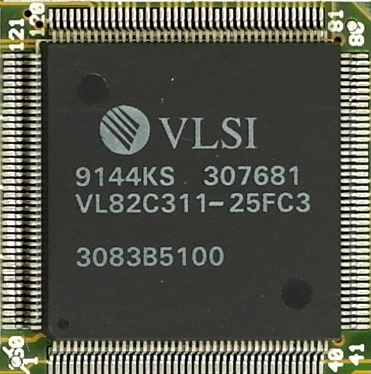 Not as common, but I still see these motherboards crop up from time to time. One advantage over the Headland HT12 and HT12/A is the VLSI chip's support for a full 16 MB of RAM that the 80286 can address. If higher memory capacity is what you want/need, this is a good choice, though there are other chipsets that also support 16 MB.
Not as common, but I still see these motherboards crop up from time to time. One advantage over the Headland HT12 and HT12/A is the VLSI chip's support for a full 16 MB of RAM that the 80286 can address. If higher memory capacity is what you want/need, this is a good choice, though there are other chipsets that also support 16 MB.
The SCAMP chipset was designed both for late 80286 motherboards and for brand new 80386SX motherboards. The "L" in the chipset's designation is for 286 boards - no "L" means it's the 386SX variant. They are not interchangeable.
Target Earth's test subject for the VLSI VL82C311L was the Biostar MB-1220VE. Unfortunately, testing on this board has yet to be documented on the TE site.
Browsing around on the Interwebs, another tester of this chipset, EJSanYo, ran some benchmarks on a PC Chips M218 motherboard with a Harris 80286-20. Running Landmark 2.0 the result was 25.09. The Check-It v3.0 result was 4250 Dhrystones/sec. Pretty respectable, though not as good as the Headland clock for clock.
Boards that are known to use this chipset are:
- PC Chips M218
- Biostar MB-1220VE
VLSI VL82C201
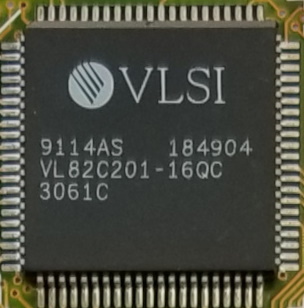 Older than the SCAMP chipset, the '201 is actually considered one of the fastest 286 chipsets you can get - faster than its successor, the '311! Some have managed to get up to 27.5 MHz stable using the VL82C201-16Q variant chipset, and a little less stable at a whopping 30 MHz! VLSI also produced a faster VL82C201-20Q variant of this, which by default is rated for up to 20 MHz instead of 16 MHz - these seem to be incredibly rare.
Older than the SCAMP chipset, the '201 is actually considered one of the fastest 286 chipsets you can get - faster than its successor, the '311! Some have managed to get up to 27.5 MHz stable using the VL82C201-16Q variant chipset, and a little less stable at a whopping 30 MHz! VLSI also produced a faster VL82C201-20Q variant of this, which by default is rated for up to 20 MHz instead of 16 MHz - these seem to be incredibly rare.
Boards that are known to use this chipset are:
- Dunson Electronics 286-16 - uses the VL82C201-16Q variant of this chipset
- Various unknown 286 boards from the mid-90s
Vogons contributor Kix runs an unknown-branded 286 board with this chipset and a Harris 80286-25. The board's AMI-286 BIOS string was DVL2-1160-040990-K8. Other installed hardware he used was a Cirrus Logic CL-GD5420 (512 KB), Intel 287XL coprocessor, 1 MB of DIP-20 Siemens 60ns RAM (heatsinked to keep them cool).
Here were the benchmark results when run at 25 MHz:
Norton SI 6.0: 19.4Check-It 3: 6374 Dhrystones/sec
NSSI 6: 6215 Dhrystones/sec
Comptest 2.60: 6681.6 Dhrystones/sec (18.3x that of an XT)
Landmark 2.0: 33.34MHz AT
Landmark 6.0: 39 MHz AT
Wolfenstein 3D time demo: 18.8 FPS
3DBench: 10.5
With a 40 MHz clock (crystal), meaning the 286 was running at 20 MHz, the benchmark results were:
3DBench: 8.4
He also got it to boot at 30 MHz after setting RAM wait states (WS) from 0 to 1, but this benchmarked slower than at 25 MHz with 0 WS.
The verdict on the VLSI VL82C201-16Q is that it's possibly the best-performing 286 chipset out there. Despite its more commonly-seen rating of just 16 MHz, when coupled with a decent late-286-era motherboard, a Harris 80286-25 and a fast ISA graphics card, both synthetic and real world performance shows it's a winner, clocking in around the same as a 386DX-33.
Suntac ST62C251
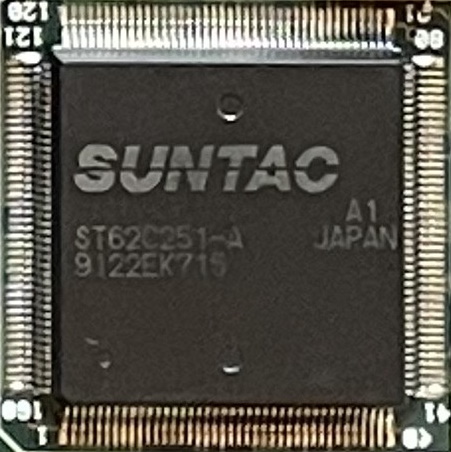 The ST62C251, like the VLSI SCAMP chipset, was designed for use in both 80286 and 80386SX motherboards. This chipset can provide 128 KB of shadow RAM with a Suntac device driver, up to half of which can realistically be used as UMBs (Upper Memory Blocks), alongside the 128 KB used for EMS. The chipset supports up to 20 MHz 286 microprocessors.
The ST62C251, like the VLSI SCAMP chipset, was designed for use in both 80286 and 80386SX motherboards. This chipset can provide 128 KB of shadow RAM with a Suntac device driver, up to half of which can realistically be used as UMBs (Upper Memory Blocks), alongside the 128 KB used for EMS. The chipset supports up to 20 MHz 286 microprocessors.
UMC UM82C210
 The UMC UM82C210 is another chipset that can work in both 80286 and 80386SX motherboards. With 80ns DRAMs, it can drive the microprocessor at up to 20 MHz. It fully supports LIM EMS 4.0, with up to 8 MB of RAM accessible, as well as shadow RAM for both the video ROM and system BIOS. The decoupled AT bus from the CPU clock allows for solid reliability from the bus while running a much faster CPU.
The UMC UM82C210 is another chipset that can work in both 80286 and 80386SX motherboards. With 80ns DRAMs, it can drive the microprocessor at up to 20 MHz. It fully supports LIM EMS 4.0, with up to 8 MB of RAM accessible, as well as shadow RAM for both the video ROM and system BIOS. The decoupled AT bus from the CPU clock allows for solid reliability from the bus while running a much faster CPU.
SA1
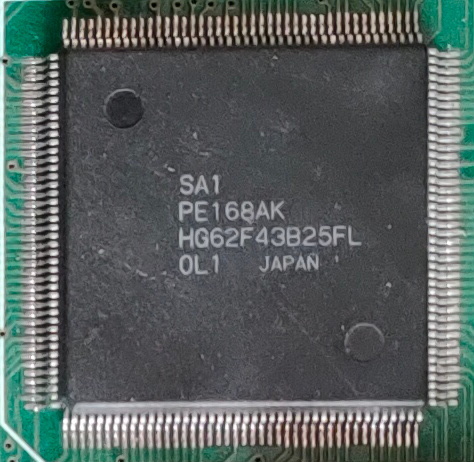 Thanks again to TargetEarth.net for testing the performance of a Peaktron PA286-SA1 board fitted with the little-known SA1 chipset (also called PE168AK). The American Megatrends 286 BIOS from 1990 had this BIOS string on startup: D286-6182-101590-K8. It supports the full 16 MB of RAM that the 80286 can address, as well as BIOS shadowing options and wait state settings.
Thanks again to TargetEarth.net for testing the performance of a Peaktron PA286-SA1 board fitted with the little-known SA1 chipset (also called PE168AK). The American Megatrends 286 BIOS from 1990 had this BIOS string on startup: D286-6182-101590-K8. It supports the full 16 MB of RAM that the 80286 can address, as well as BIOS shadowing options and wait state settings.
From factory this board came with a 16 MHZ 80286, and associated 32 MHz crystal. In order to run at 0 wait states, 70ns SIMMs were insufficient. The tester had to locate 60ns 1 MB Siemens-branded ones which then worked with the mainboard set to 0 WS.
Benchmark results at the standard 16 MHz (at 1 wait state) were:
Norton SI 6.0: 9.2Check-It 3: 3157 Dhrystones/sec
Comptest 2.60: 3323.5 Dhrystones/sec (9.1-fold of XT)
Landmark 6.0: 18.53 MHz AT
3DBench: 5.5 (Trident TVGA9000 512K)
and when run with zero wait states:
Norton SI 6.0: 12.1Check-It 3: 4042 Dhrystones/sec
Comptest 2.60: 4198.2 Dhrystones/sec (11.5-fold of XT)
Landmark 6.0: 24.67 MHz AT
Wolfenstein 3D time demo: 11.6 FPS
3DBench: 6.1 (Trident TVGA9000 512K), 6.5 (Tseng Labs ET4000AX 1MB)
Benchmark results at 20 MHz or 25 MHz were unobtainable, so it's likely this chipset tops out at 16 MHz to run reliably.
Test Results So Far
So with Norton System Information v6.0, here's how the results I mention above compare:
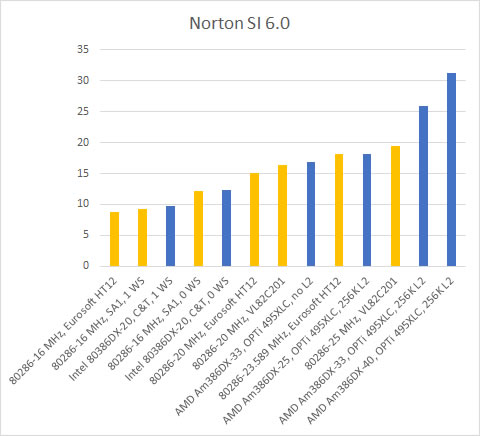
Yellow = 80286 results, blue = 386DX results
Looking at this, the Headland HT12 gave a really decent bump in performance once pushed to 20 MHz, though the SA1 chipset with zero wait states performed well at 16 MHz.
There appears to be no hope of a 25 MHz 80286 reaching the performance of a 386DX-33 with a decent L2 cache, but both the Headland HT12/A and the VLSI VL82C201 beat an old 386DX with C&T chipset (no L2 cache) at 20 MHz. The top score in Norton SI 6.0 went to the VL82C201, just edging ahead of a 386DX-25 running the respectable OPTi 495XLC chipset.
For the dhrystones/sec performance comparison, here were the results:
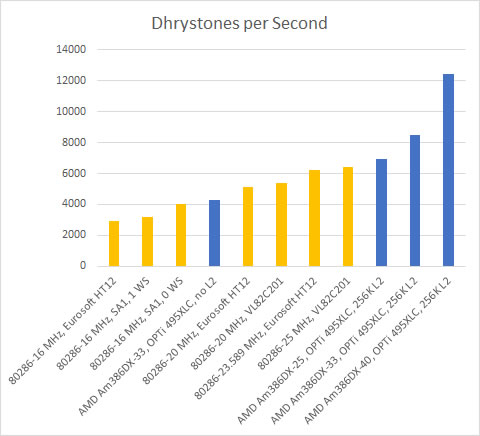
The 286s running at just 16 MHz did well against the 33 MHz 386DX with no L2 cache in raw integer performance (dhrystone formula), getting between 60% and 95% of the 386's score. When pushed to the higher clock speeds, again the VL82C201 just edged ahead of the HT12/A.
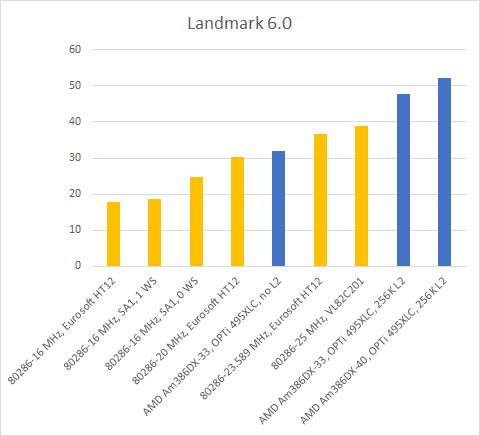
Without a L2 cache, the 386DX-33 again scored lower than both the HT12/A and VL82C201 chipsets with the faster-clocked 80286 chips, running at 23.5 - 25 MHz.
If I recall some research I did many moons ago, the 286 takes fewer clock cycles to perform certain instructions than the 80386 does, but this is usually masked by the 386's higher clock speeds and motherboard (Level 2) cache. In summary, the 286 is more efficient internally than the 386. This would explain the results we see here.
My Tests
So all of the above test results are from other enthusiasts - I have no way to confirm or deny that these are accurate. As such, I have an HT12/A motherboard being delivered in a few days, so will test more when it arrives. Here a pic of the board:
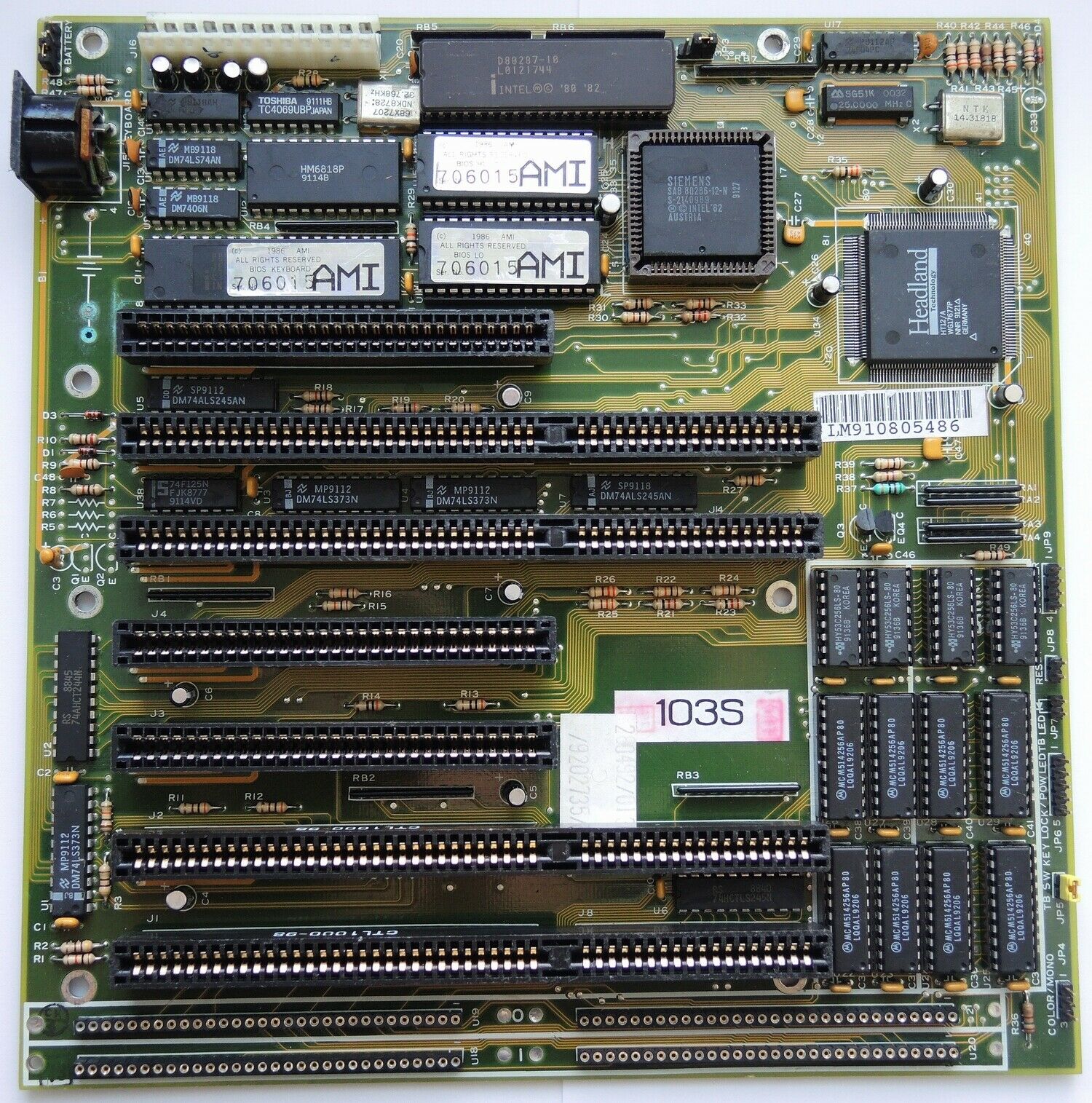
What I think is an LM103S, though its layout differs from Stason.org
At present the board is running a Siemens-branded 80286 at the sedentary speed of 12 MHz, but with that HT12/A and the fact that it's a "modern"-design Baby AT board, I feel this can be pushed a bit. The 80ns DRAMs are surely going to be a bottleneck to eeking out the best from it, and the SIPP slots will be a pain unless I can fashion some sort of SIPP-to-SIMM adapter.
I am particularly keen to do proper real-world testing with games such as Wing Commander and Wolfenstein 3D with different graphics cards, and run some comparisons between some lower-end 386s and this. Join me in Part 2...
